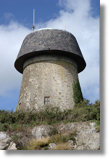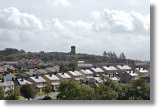Melin Wynt-y-Craig
This is a prominent landmark in the Anglesey county town of Llangefni. It stands on a rocky crag above the town and can be seen from miles around. This location gives it excellent exposure to the wind, but would have been problematic for the farmers who needed to bring their grain up the steep paths.
It was built sometime between 1828 and 1833. In 1828 Pigot's commercial directory only lists a watermill in Llangefni whereas the next edition in 1833 mentions the Craig Mill, which was being run by William Hughes.
The Pencraig estate on which it stood was owned at the time by Richard Poole. In 1839 the mill and the rest of the estate were sold to Richard Griffith of Fitzwilliam Place, Dublin. He later became Sir Richard Griffith, 1st Baronet. He was a geologist and mining engineer and is well known in Ireland for both creating the first geological map of the country and for compiling the land survey and valuation of Ireland known as Griffith's Valuation (widely used in family history research in Ireland today).
In the 1843 tithe apportionment Richard Griffith is shown as owner of the mill as well as more than 465 acres in the Llangefni area. The mill was actually occupied by Rowland Owen and John Williams. Rowland, who lived on Bridge Street, continued in charge of the mill until his death in 1876, assisted by other millers who actually occupied the residence at the mill. In 1861 two young men, Richard Williams and Henry Roberts were living at the mill. Henry was the son of Richard Roberts of Melin Hermon, and Richard may have been the son of the miller at Melin Manaw (also called Richard).
In 1869 the mill and the rest of the Pencraig estate were transferred by Sir Richard to the ownership of his daughter Elizabeth and her husband Robert Bramston Smith (a Major in the County of Dublin Light Infantry Regiment of Militia), their two daughters Frances and Elizabeth, his half brother Walter Hussey Griffith and his son George Waldie Griffith. The daughters inherited the estate in 1907 after their parents' deaths.
By 1871 William Williams had taken over day to day running of the mill. He was the son of the miller, also called William, of Penrhiw watermill in Cerrigceinwen. He ran the mill through the 1870s and 1880s, but in 1887 he and his family emigrated to Manitoba, Canada where they had a large farm. His three Llangefni-born children, who never married, later took over the farm. Tragically, all three died in a house fire in 1956.
The mill closed in 1893. The last miller, William Jones, was also the last miller of two other Anglesey mills, thus earning himself the nickname Angau Melinau (Angau being the personification of death in early Welsh legends, and melinau meaning "mills").
By 1914 the estate had come into the hands of the Daniell family through the marriage of Sir Richard Griffith's great granddaughter Maud Phipps. In that year the mill and the surrounding Craig Fawr farm was sold to what was then called the Urban District Council of Llangefni. The rest of the estate was sold in 1952 to provide housing for the growing population of the town.
As with most disused mills, the sails and machinery were eventually removed and only the empty shell was left by the 1930s, as shown by the Muggeridge photos below. Towards the end of the 20th century it had become something of a trouble spot for the youth of the housing estates that had grown up around it. In 1995 work began to restore it. A distinctive cap was placed on it and it was used to house mobile phone transmitter equipment with a mast on the top. In 2020 the phone equipment was moved out and the council began looking for an alternative use for it, advertising it for rent for £7500 a year.
See other images of this windmill at:
- Windmill World
- Anglesey.Info
- Wikipedia
- Geograph
- Images taken in 1936, front and side, and 1939, from the Donald W. Muggeridge Collection of Mill Photographs, University of Kent, Canterbury
More information at:
![]() Melin Penrhiw, Llangefni or go to gallery.
Melin Penrhiw, Llangefni or go to gallery.
Aerial image
View Windmills of Anglesey in a larger map
A new book by Warren Kovach, author of this web site



